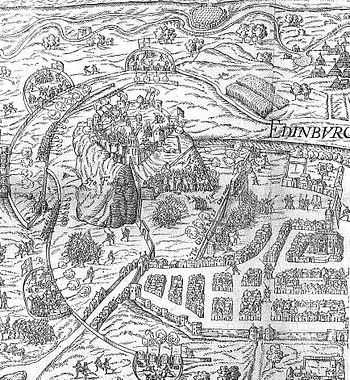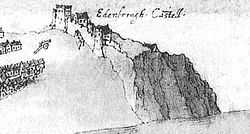Migliorino Ubaldini

Migliorino Ubaldini (active 1548), known also as "Captain Mellerin," was an Italian military engineer working in Scotland. He designed new fortifications at the entrances of Edinburgh Castle, Dunbar Castle, and possibly the walled town of Leith.
Scottish assignment
During the war with England known as the Rough Wooing, on 5 February 1548 Regent Arran appointed Migliorino Ubaldini as supreme commander of all Scottish forces by land and sea. Ubaldini had been sent to Scotland by Henry II of France who called him a famous captain. Despite this, Marcus Merriman, a modern historian, found no recorded details of his previous career. Merriman linked Ubaldini's appointment in Scotland with Lord Methven's plea to Mary of Guise in December 1547 for a French captain who had intelligence to assiege and order artillery.[1]
Two letters written by Ubaldini in 1548 to Mary of Guise survive.[2] In 1548/9 he wrote two letters to the brother of Mary of Guise, the Duc d'Aumale, which note a French form of his name as; "Captain Mellerin."[3]
Other Italian engineers who worked in Scotland for the Scottish side during the Rough Wooings include Leone Strozzi, Piero Strozzi, and perhaps Giovanni Portinari, who Nicolas Throckmorton later recruited for English service because he already spoke Scots.[4] At the same period, there was another Ubaldini in Scotland; Petruccio Ubaldini, who fought for English at Haddington.[5]
Fort of the castle hill
While the English were fortifying Haddington, in March 1548 Ubaldini was working to strengthen Edinburgh Castle. A lodging was found in the Royal Mile for the "Italiane devisar of the forte of the castle hill." Where Master John Hamilton of Milnburn had begun building a rampart in the previous year, Ubaldini commenced the construction of a renaissance style 'trace italienne' fortification in front of the castle on the present esplanade. Some of the timber and stone used was obtained from the woods and house of Alexander Crichton of Brunstane who had sided with England. His friend and ally Ninian Cockburn vowed it would never be finished, writing, "yon neu blak hous quhilk will nocht cum abof the erde."[6]
The triangular blockhouse became known as the Spur. The Imperial envoy Mathieu Strick noted in July 1551 that the completed Spur was decorated with the arms of France.[7] There had been a French contribution of at least £4070 Scots for the work.[8]
Mary of Guise strengthened the 'Esperon' in April 1560.[9] She held a parley in the "blockhouse at the first gate of the castle" before the commencement of the siege of Leith and according to John Knox, watched fighting at Leith from the "foir wall" of the Castle.[10]
The spur was described by Rowland Johnson, Surveyor of Berwick upon Tweed who came to assist the siege of Edinburgh Castle on 26 January 1573 during civil war in Scotland;"we fynd upon the said este syde a spurre lyke a bulwarke standing befor the foot of the rocke, which spurre enclosethe that syde flanked out one bothe sydes; on the sowthe syde is the gaite wher they enter the castle. Which spur is like 20 foote high vamured with turf and basketes set and furnished with ordinance."[11]A woodcut illustration of Ubaldini's spur appeared in Holinshed's Chronicle depicting the 1573 siege which may derive from a drawing made by Johnson. Ubaldini went on to design works at Dunbar Castle in September which were demolished in 1567, and perhaps at Stirling Castle where there are remains of a similar work, called the 'French Spur,' still French insignia.[12]
The Spur was finally demolished in 1650, and the stones were taken for the use of John Milne for the town's building work at the Parliament House and the Citadel and fortifications at Leith. It was planned to erect the gate arch at the Parliament.[13]
Thomas Fisher, the Spur and Bulwark at Leith

"Lastely he (Thomas Carlile) saith, that having had libertie to walke abrode in the towne of Edenbrughe with his taker, and somtymes betwene that and Leghe, he telleth that Leghe is entrenched round aboute, and that, besides a bulwarke made by the haven side towardes the sea on the ground where the Chapell stode, which I suppose your Grace remembreth, there is an other greater bulwerk made on the mayne ground at the gret churche standinge at the upper end of the towne, towardes Edenbrughe.
And that their engener having at the firste comyng of the Frenche, devised a traves walle, betwene the towne of Edenbrugh and the castell, the same, saith he, is alredy a good piece builded and rysen brest highe of a man, at the charges [of] the Governor, which wall, with a poynted bulwerk in the myddes, ronneth by the jugement of his eyes to'whart the grene where Sir Christopher Moires planted th'ordenance at your Graces first approche there, in sorte here under grocely pricked out, and at the south end thereof is th'entreet her unto, which distaunce seameth to be like a base court to the castell."[15]
Footnotes
- ↑ Calendar State Papers Spain, vol.9, (1912), 246: Merriman, Marcus, The Rough Wooings, Tuckwell (2000), 321-323: Cameron, Annie I., ed., The Scottish Correspondence of Mary of Lorraine, SHS (1927), 208-211.
- ↑ Merriman, Marcus, The Rough Wooings, Tuckwell (2000), 327-330: illustrations in Merriman, (1999)
- ↑ Omont, Henri, Catalogue général des manuscrits Français de la Bibliotheue Nationale, vol.1, (1868), p.129, 138
- ↑ Calendar State Papers Foreign Elizabeth, 1559-60, Longman (1865), 110, Killigrew to Elizabeth, 14 November 1559.
- ↑ Merriman, Marcus, The Rough Wooings, Tuckwell (2000), 370.
- ↑ Accounts of the Lord High Treasurer of Scotland, vol. 9 (1911), pp. 56, 161-163: CSP Scotland, vol.1 (1898), p.93 no.190, p.97 no.195, p.108 no.220
- ↑ Calendar State Papers Spain, vol. 10 (1914), 340.
- ↑ Accounts of the Lord High Treasurer of Scotland, vol. 9 (1911), 21.
- ↑ Calendar of State Papers Foreign Elizabeth 1559-1560, Longman (1865), 604, no. 1093.
- ↑ Bruce, John, ed., John Hayward's First Four Years of Elizabeth, (1840), p.55: Knox, John, History of the Reformation, Book 3.
- ↑ Calendar State Papers Scotland, vol. 4 (1905), 475:quoted in Merriman, Marcus, The Rough Wooings, (2000), 325.
- ↑ Fawcett, Richard, Stirling Castle, Historic Scotland, Batsford, (1995), 65-6.
- ↑ Wood, Marguerite, ed., Extracts from the Burgh Records of Edinburgh, 1642-1655, (1938), 196-7, 241 etc.
- ↑ Calendar State Papers Scotland, vol.1 (1898), 68, 70
- ↑ Ellis, ed., Original Letters Illustrative to British History, series 3 vol.3 (1846), pp.299-300, includes the sketch
Further reading
- Merriman, Marcus H., 'Intelligens to asseg - Migiliorino Ubaldini and the Fortification of Scotland in 1548,' in Achitetti e ingegneri militari italiani all'estero dal XV al XVII Secolo, vol. 2, ed., Marino Viganò, Rome (1999), 233-255.
- Merriman, Marcus H., The Rough Wooings, Tuckwell (2000)
External links
- Spur rediscovered in 2010 - Historic Scotland
- Spur rediscovered in 2010 - BBC news 15 January 2010
- Stirling Castle - c. 1550 fortifications discovered - BBC news 2 March 2011